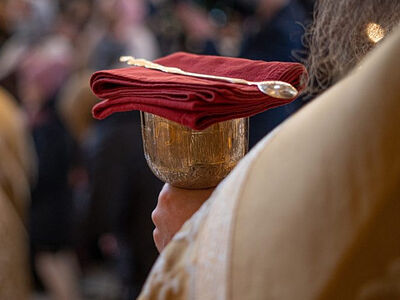 The Ability to Recognize the Divine, Part 1You can glorify God not so much with the creation of your own hands—with the beautiful interior of churches, icons, and vestments—as with an inner spiritual response, feeling God’s presence where His voice is heard.
The Ability to Recognize the Divine, Part 1You can glorify God not so much with the creation of your own hands—with the beautiful interior of churches, icons, and vestments—as with an inner spiritual response, feeling God’s presence where His voice is heard.
“>Part 1

Ye shall not see me henceforth, till ye shall say,
Blessed is He that cometh in the name of the Lord!
(Mt. 23:39)
It’s impossible for man to see God. But the Son Whom He sent utters Divine words in human language and reveals God’s truth about being in this world: Woe unto you, scribes and Pharisees, hypocrites! because ye build the tombs of the prophets, and garnish the sepulchres of the righteous (Mt. 23:29). He mainly exposes the hypocrisy of the people and their leaders, recalling that before building monuments to them, they executed the prophets by stoning.
In the Orthodox tradition, it’s customary to reverently celebrate the memory of the venerable saints who glorified Christ with their lives, fasting, and prayer. The relics of the saints that repose in the Far Caves [of the Kiev Caves Lavra—Trans.] often retain the temperature of a living body. This leads to a clear and simple human thought, which is confirmed and strengthened by the Liturgy. The Sacrament of liturgical  Russian Priests on How not to Lose Grace after CommunionBeing the heart of the spiritual life, the Eucharist requires that we should be vigilant and attentive to our actions, words and thoughts.
Russian Priests on How not to Lose Grace after CommunionBeing the heart of the spiritual life, the Eucharist requires that we should be vigilant and attentive to our actions, words and thoughts.
“>Communion, always celebrated by Christ Himself, is shared by our being with Him. This is the Communion of a living Person, not of someone whose tomb was adorned by men, who once existed and has departed forever, having been inconvenient for the authorities and the people.
Like the ancient prophets, Christ rebuked, and the people wanted to get rid of Him just as they got rid of the prophets. It’s not easy to accept the Divine holiness and the presence of the Living God in the human and of the living Man in the Divine. This doesn’t fit into the concept of the Divine. God is always in Heaven, infinitely far away, incomprehensible and unseen—it’s easier and more understandable to live this way. You can organize your life according to your own rules and claim that these are Divine rules.

Long ago, the Divine rules were given by holy men and prophets. Centuries later, they were so “overgrown” with human laws—the tradition of the elders—that they hid the Living God in a living man from the Pharisees and lawyers of that time. They crucified the One sent by God. Perceiving Christ, crucified by the “hands of the lawless,” by faith, it’s important to realize that He became man and reveal God to men in fullness when He resurrected in His Divinity and humanity. Until we accept Him as alive “here and now,” we won’t see Him at all. Instead of “building tombs,” that is, creating only “material objects” for His worship, we must strive with our hearts and, worshiping Him eucharistically, cry out: Blessed is He that cometh in the name of the Lord! (Mt. 21:9).
The main content and meaning of the Eucharist naturally resonates in man—we worship not an object or an idea, but rather the Living God. He lives in us and among us, filling life with Himself and the human heart with the jubilant exclamation: Blessed is He that cometh in the name of the Lord! And incorrupt relics with the temperature of a human body “cry out” to men—Alive and Living! The man is worthy of veneration in Christ!
We mustn’t again become pharisees and scribes, who revered tombs filled with bones, or venerated the “boards and paint” of images and the stone of sculptures. In an icon we venerate the face—the image of the One Who is the manifestation of Divine-human perfection. Perfection is above all the life in man himself. Perceiving life as it is, we correctly strive towards God and tirelessly exclaim the wonderful words: Blessed is He that cometh in the name of the Lord—the One Whom God sent and Who has both a Divine and human name. Through faith in Him, God has become visible and known, perceivable and cognizable in Christ Jesus Whom He sent.